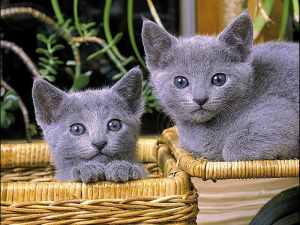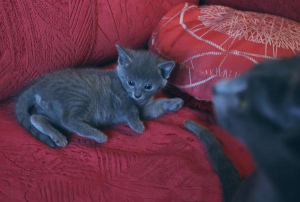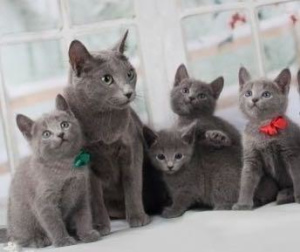Russian Blue
The plush wool of this breed falls in love with absolutely everyone. If you are considering starting a Russian Blue, check out our article and you will learn more about its history and content features.
- Origin Russia, Growth 20 - 40 cm., Weight 3 - 6 kg.
- Lifespan 15-20 years
Popularity
Wool length
Size
Health
Mind and wit
Name of the breed: Russian Blue
Fit for allergics: Yes
For families with children: Yes
Difficulty of care: No
 Facts about Russian Blue
Facts about Russian Blue
- An important fact for many about the Russian Blue will be that they do not cause allergies.
- These cats have excellent health.

- Many owners note this fact about the Russian Blue: due to the peculiarities of the head structure and the severity of the pads, the feeling of a cat's smile is present on the face.
- Today is not so easy to buy Russian blue. Many breeders complain that finding a representative that fully meets all standards is very difficult.
- Russian blue is divided into three subtypes: American, Scandinavian and English.
_120x126.jpg) Origin of Russian Blue
Origin of Russian Blue
It is not difficult to guess which country gave the origin of the Russian blue. This is Russia. It was from there at the end of the 19th century that the famous breeder from England (Karen Cox) took out several kittens, whose breeding was subsequently taken up.
On the way, Karen had many difficulties, in particular with the fact that there were very few representatives of the species and had to use four-legged other breeds. In some cases, this had a negative effect on the exterior of the kittens.
World War II was also reflected in the Russian Blue cat. She was almost completely destroyed. In order for the species not to be lost, breeders had to carry out really titanic work, as a result of which the modern breed standard was approved.
 Description of Russian Blue
Description of Russian Blue
Cats of this breed are distinguished by grace and elegance. Their torso is elongated, located on long, slender limbs with round legs. The tail is long and sharpens closer to the tip.
Their heads are elongated, flat on top and straight in profile. The face of the vibrissae is clearly visible on the face. The eyes are almond-shaped, their color is strictly green.
Coat is the next item in the description of the Russian blue. It consists of a thick undercoat and short, soft guard hair. Color is possible only gray. The presence of any white spots is undesirable.
 Character Russian blue
Character Russian blue
Aristocracy and refinement are central elements of the Russian Blue character. These pets are ideal for family life: they can equally well lie down on the knees of an adult owner and play with small children.
In dealing with strangers, they show detachment and wariness until a person deserves their trust. The manifestation of aggression is not peculiar to them.
 Care for the Russian blue
Care for the Russian blue
In the content of these pets do not cause trouble to their owners. Walking them is not necessary, as well as an important advantage is that they are very clean. Often they can not be bathed, because it destroys the protective properties of the cover. It is necessary to comb out several times a week to help the four-footed to get rid of dead wool.
There are no features of care for Russian Blue. Ears should be cleaned about once a week, preferably using special products from the pharmacy for this purpose, the eyes are washed every day, and the claws are trimmed as they grow.
Do not be afraid to start a pet, if there are children at home. These cats very quickly find common language with them and are always happy to take part in any of their games. But with other animals in the house may cause problems. This is due to the capriciousness of cats. In order for animals to get along well it is better that they grow together from a very young age. Otherwise, there may be a reason for aggression.
_120x106.png) How to feed the Russian blue?
How to feed the Russian blue?
Feeding adults should be carried out 2 times a day - in the morning and in the evening. Only the owner decides how to feed the Russian Blue. He can rely only on the advice of professionals: breeders and veterinarians. The issue of nutrition is very important, since it affects the health and beauty of the pet's hair.
Allowed as a diet consisting of dry food, and natural products. The main thing is to find a balanced, high-quality, healthy menu.
If we are talking about natural food, it should be meat, fish, offal, cereal and milk. And if the choice fell on food, then it should be with a good composition.
Do you like this breed? Choose a suitable offer on PetGlobals.com!
We collected the advertisements from all around the world and placed them on international platform for buying/selling pets. Only on our Web-site you can find the most rare breeds of cats and dogs!
Advertisements for buying/selling cats
Advertisements for buying/selling dogs
With help of PetGlobals.com your future pet is closer to you!
 Select language
Select language 












.png)
